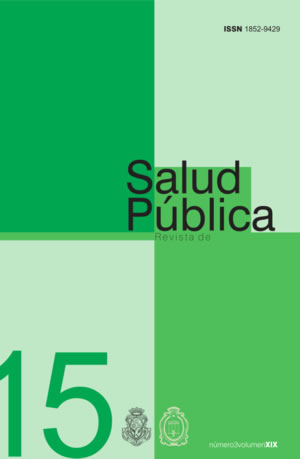HEALTH AS A RIGHT IN THE FOUNDING MISSION OF THE SCHOOL OF PUBLIC HEALTH, SCHOOL OF MEDICINE, UNIVERSITY OF CHILE: A HISTORICAL ANALYSIS
DOI:
https://doi.org/10.31052/1853.1180.v19.n3.13072Keywords:
History, School of Public Health, Right to healthAbstract
The historical context in which the School of Public Health of the University of Chile was born is explored in this work. The period studied goes from the end of the 19th century to middle of the 20th Century. In the first place, the position of the four key actors - the elite, doctors and health professionals, popular layers, and the State - and their conflicts are analyzed. In the second place, the change of paradigm in the role of the State regarding health problems, from a position of “Subsidiary Gendarme State” to a new position of “Welfare Committed State” is studied. The School of Public Health was born as a result of these historical processes, to cover the need to train specialists in the field of public health, getting external support from the Rockefeller Foundation which was essential in its beginnings. Since its origin it has been greatly involved in the country´s public life, understanding people´s health as a social right.
Downloads
References
1. Illanes MA. “En el nombre del pueblo, del estado y de la ciencia”: historia social de la salud pública Chile 1880/1973 : hacia una historia social del siglo XX. Colectivo de Atención Primaria; 1993. 520 p.
2. Salinas R. Salud, ideología y desarrollo social en Chile, 1830-1950. Cuad Hist. julio de 1983;No3:99–126.
3. Obregón D. Médicos, prostitución y enfermedades venéreas en Colombia. 1886-1951. Hist Cienc Saúde Manguinhos. 2002;9.
4. Memorias del Tiempo Viejo. Luis Orrego Vicuña. Ed. Univ. De Chile. 1984. Stgo. De Chile en Laval E. El cólera en Chile (1886-1888). Rev Chil Infectol. 2003;(Edición Aniversario):86–8.
5. Evans R. Epidemics and Revolutions: Cholera in Nineteenth-Century Europe. Past Present. agosto de 1988;120:123–46.
6. Ferrer R. PL. Álbum Gráfico del Instituto de Higiene de Santiago. 1910.
7. Constitución Política de Chile de 1833.
8. Vargas Cariola JE. Los Médicos Entre la Clientela Particular y los Empleos del Estado, 1870-1951. Ars Médica Rev Estud Méd Humanísticos. 2003;7(7).
9. Urtubia F. Vacunación fozosa versus libertades individuales: la controversia parla-mentaria en torno al proyecto de Ramón Allende Padín. 1876-1882. An Hist Med. 2006;16.
10. Hevia P. Los inicios de la Escuela de Salubridad de Chile. Rev Chil Salud Pública [Internet]. 2006;10(3):170–6. Recuperado a partir de: http://www.revistapolitica.uchile.cl/index.php/RCSP/article/viewArticle/2544
11. Boletín del Ministerio de Higiene, Asistencia y Previsión Social. Imprenta Nacio-nal, Santiago de Chile.; 1927. 12. Cruz-Coke M R. Síntesis biográfica del doctor Salvador Allende G. Rev Médica Chile [Internet]. julio de 2003;131(7):809–14. Recuperado a partir de: http://www.scielo.cl/scielo.php?pid=S0034-98872003000700014&script=sci_arttext
13. Pino P, Solimano G. The School of Public Health at the University of Chile: origins, evolution, and perspectives. Public Health Rev [Internet]. 2011;33(1):315–22. Re-Public Health Rev [Internet]. 2011;33(1):315–22. Re-cuperado a partir de: http://www.doaj.org/doaj?func=fulltext&aId=864234
14. Cueto M. Salud, cultura y sociedad en América Latina. Instituto de Estudios Perua-nos; 1996. 262 p.
15. Escuela de Salubridad. Memoria Anual 1944. 16. Rosen G. De la policía médica a la medicina social: ensayos sobre la historia de la atención a la salud. En: De la policía médica a la medicina social: ensayos sobre la historia de la atención a la salud. Siglo XXI; 1985.
Downloads
Published
Issue
Section
License
Copyright (c) 2015 Escuela de Salud Pública y Ambiente. Facultad de Ciencias Médicas. Universidad Nacional de Córdoba

This work is licensed under a Creative Commons Attribution-NonCommercial 4.0 International License.
Authors who publish with this journal agree to the following terms:
- Authors retain copyright and grant the journal right of first publication with the work simultaneously licensed under a Creative Commons Attribution License which allows the work to be copied, distributed, exhibited and interpreted as long as it is not done for commercial purposes.
- Authors are able to enter into separate, additional contractual arrangements for the non-exclusive distribution of the journal's published version of the work (e.g., post it to an institutional repository or publish it in a book), with an acknowledgement of its initial publication in this journal.
- Authors are permitted and encouraged to post their work online (e.g., in institutional repositories or on their website) after the publication process. (See The Effect of Open Access). (See The Effect of Open Access).







